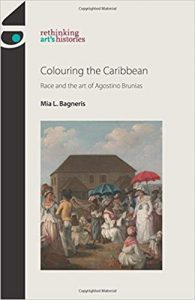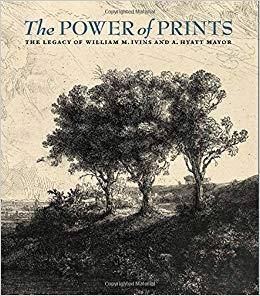CAA News Today
New in caa.reviews
posted by CAA — March 29, 2019
Meredith Gamer reviews Colouring the Caribbean: Race and the Art of Agostino Brunias by Mia L. Bagneris. Read the full review at caa.reviews.
Christine Giviskos reviews The Power of Prints: The Legacy of William M. Ivins and A. Hyatt Mayor by Freyda Spira and Peter Parshall. Read the full review at caa.reviews.
Serve on a CAA Award Jury
posted by CAA — March 28, 2019
CAA invites nominations and self-nominations for individuals to serve on ten of the fourteen juries for the annual Awards for Distinction for three years (2019–22). Terms begin in May 2019; award years are 2020–22.
CAA’s fourteen awards honor artists, art historians, authors, curators, critics, and teachers whose accomplishments transcend their individual disciplines and contribute to the profession as a whole and to the world at large.
Candidates must possess expertise appropriate to the jury’s work and be current CAA members. They should not hold a position on a CAA committee or editorial board beyond May 31, 2019. CAA’s president and vice president for committees appoint jury members for service.
Jury vacancies for spring 2019:
- The Art Journal Award: two members
- Alfred H. Barr Jr. Award: three members
- Frank Jewett Mather Award for Art Criticism: one member
- Charles Rufus Morey Book Award: two members
- Arthur Kingsley Porter Prize: two members
- CAA/AIC Award for Distinction in Scholarship and Conservation: one member
- Distinguished Artist Award for Lifetime Achievement: one member
- Distinguished Lifetime Achievement Award for Writing on Art: two members
- Distinguished Feminist Award: one member
- Distinguished Teaching of Art Award: one member
Nominations and self-nominations should include a brief statement (no more than 150 words) outlining the individual’s qualifications and experience and a CV (an abbreviated CV no more than two pages may be submitted). Please send all materials by email to Cali Buckley, CAA grants and special programs manager; submissions must be sent as Microsoft Word or Adobe PDF attachments. For questions about jury service and responsibilities, contact Tiffany Dugan, CAA director of programs and publications.
Deadline: May 13, 2019
News from the Art and Academic Worlds
posted by CAA — March 27, 2019
Want articles like these in your inbox? Sign up: collegeart.org/newsletter

Protesters at the Guggenheim Museum last month dropped white slips of paper symbolizing OxyContin prescriptions. Last week the museum said it would no longer accept money from members of the Sackler family behind the drug. Image: New York Times
Museums Cut Ties With Sacklers as Outrage Over Opioid Crisis Grows
The scrutiny of the Sacklers comes amid a broader reckoning in the museum world about who sits on their boards and bankrolls their programs. (New York Times)
University of Tennessee Will Be Free for Low-Income Students Starting in Fall 2020
The school joins a small—but growing—list of US colleges and universities seeking to make higher education more accessible. (Think Progress)
Study: 40% of Community College Students Take Humanities Classes
Community colleges have seen massive growth in their humanities programs over the past few decades. (Education Dive)
Museums Need to Move with the Times – That’s Why Deaccessioning Isn’t Always Bad News
“Some may view this as pandering to the politically correct. But American art museums have a moral responsibility and historical mandate inscribed in their charters to reach the broadest possible public.” (Apollo Magazine)
$2.8 Million in Met Museum Admission Revenues Will Go to 175 Cultural Nonprofits
NYC officials announced last week that funds from the Met’s change in admissions policy will be redistributed. (Hyperallergic)
Opinion: A Bigger Scandal at Colleges — Underpaid Professors
“What these folks did is not the worst thing happening in our educational system.” (Boston Globe)
Anja Foerschner and Marta Jovanovic
posted by CAA — March 25, 2019
The weekly CAA Conversations Podcast continues the vibrant discussions initiated at our Annual Conference. Listen in each week as educators explore arts and pedagogy, tackling everything from the day-to-day grind to the big, universal questions of the field.
CAA podcasts are on iTunes. Click here to subscribe.
This week, Anja Foerschner and Marta Jovanovic discuss feminist art.
Dr. Anja Foerschner is a curator, scholar, and professor at the Node Center for Curatorial Studies in Berlin.
Marta Jovanovic is an artist and founder of PerformanceHUB in Belgrade.
New in caa.reviews
posted by CAA — March 22, 2019
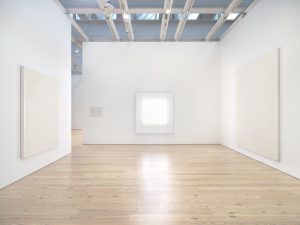
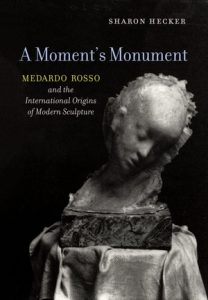 Ginger Elliott Smith reviews Mary Corse: A Survey in Light, edited by Kim Conaty. Read the full review at caa.reviews.
Ginger Elliott Smith reviews Mary Corse: A Survey in Light, edited by Kim Conaty. Read the full review at caa.reviews.
Caroline Levitt writes about A Moment’s Monument: Medardo Rosso and the International Origins of Modern Sculpture by Sharon Hecker. Read the full review at caa.reviews.
International Review: Opening of the Jameel Arts Centre, Dubai, United Arab Emirates by Sabrina DeTurk
posted by CAA — March 21, 2019
The following article was written in response to a call for submissions by CAA’s International Committee. It is by Sabrina DeTurk, associate professor, College of Arts and Creative Enterprises, Zayed University, Dubai, United Arab Emirates.
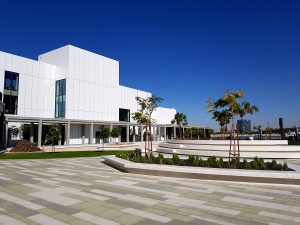
Fig. 1: Exterior of Jameel Arts Center, Jaddaf Waterfront, Dubai, UAE. Photo by Sabrina DeTurk.
In November 2018, Dubai witnessed the opening of the Jameel Arts Centre, the city’s first non-commercial contemporary arts space (Fig. 1). Located on the banks of the Dubai Creek, in the still-developing area of the Jaddaf Waterfront, the center is a project of the Saudi-based organization Art Jameel, a foundation focused on arts and culture programming that is sponsored by the Jameel family. The Jameel Arts Centre will be programmed as a kunsthalle, featuring temporary exhibitions showcasing works drawn from the Jameel collection as well as commissioned works by contemporary artists and those on loan from other institutions. Community events and educational outreach are also key elements of the center’s programming initiatives and the 107,640 square-foot space includes facilities such as an open-access library of over 3,000 volumes as well as coworking areas. There will also be a sculpture park as well as an outdoor arena for performing arts or film screenings.
The Jameel Arts Centre’s inaugural exhibitions included a series of artist’s rooms featuring the work of women artists from the Middle East whose work has garnered critical acclaim though not always international visibility. Maha Al Malluh (Saudi Arabia), Mounira Al Solh (Lebanon), Lala Rukh (Pakistan), and Chiharu Shiota (Japan) showed work that reflected on the personal, communal, and political, sometimes all in one piece.
In Maha Al Malluh’s sculpture, Food for Thought, dozens of well-used cooking pots of all sizes are affixed to two walls of the gallery with their undersides facing the viewer. The burns, scrapes and dents on these surfaces become both a pattern and a portrait, suggesting the many meals, large and small, cooked and served in these vessels. The pots invoke both an individual and collective activity of dining. One senses that these pots have traveled far to reach their current destination, perhaps reflecting the experience of refugees who have fled from so many troubled parts of the region, often with few possessions other than simple cooking utensils and basic clothing.
Lala Rukh’s minimalist and meditative prints and video speak to the personal experience of her mother’s death as well as the changing political landscape of Southeast Asia in the 1990s. However, the darkness of the room in which the works are displayed made it all but impossible to read the contextualizing and interpretive materials that are necessary to understand the meaning of Rukh’s subtle forms.
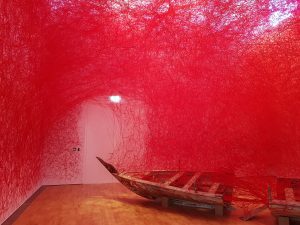
Fig. 2: Installation view of Chiharu Shiota, Departure (2018). Photo by Sabrina DeTurk.
The inclusion of a sculptural installation by Chiharu Shiota, featuring an Arabian dhow (sailing vessel) sourced from a local boatyard, struck an odd note among the rooms (Fig. 2). While Shiota’s sculpture, which featured her signature webs of red yarn, was visually compelling, there was little sense, beyond the inclusion of the local boat, of its contribution to the larger dialogues encouraged by the exhibitions. In an image-obsessed city such as Dubai, one can’t help but wonder if this installation served more as an Instagrammable photo opportunity than as a work of serious contemporary art.
The inaugural group exhibition at Jameel Arts Centre, Crude, was curated by Murtaza Vali and featured the work of eighteen artists and artist collectives. In the show’s catalogue, Antonia Carver, the Director of Art Jameel, described the exhibition as “presenting an innovative material reading of a substance so crucial in shaping local and regional histories and cultures.” The included works run the gamut from archival photographs to video to sculptural installations to found objects and reflect a diversity of artistic approaches to the cultural, political, and economic significance of oil in the region throughout the last six decades.
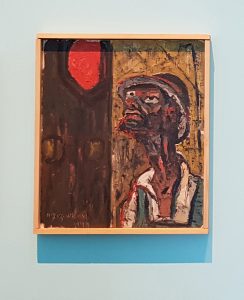
Fig. 3: Houshang Pezeshknia, Portrait d’homme (1949). Photo by Sabrina DeTurk.
The earliest works in the show, documentary photographs by the Iraqi, Latif Al Ani, and paintings by the Iranian, Houshang Pezeshknia (Portrait d’homme, 1949, Fig. 3), highlight the role that the discovery of oil played in shaping the modern culture and identity of both countries. Al Ani’s photographs focus on the material benefits of the oil industry, featuring images of new, modernist housing developments and smiling children showing the bottles of milk now provided as part of the government school lunch program. Pezeshknia’s paintings are more introspective; their rough brushstrokes emphasize the harsh features of those who work on the pipelines and the scars left on the Iranian landscape by the new technologies of oil extraction.
Several artists in the exhibition drew on found images and archival film footage for their works. These include Raja’a Khalid, whose Desert Golf series (2014) uses vintage print media from American publications such as Life magazine to document the seemingly inexorable, if equally inexplicable, compulsion that expatriate oil executives had for finding ways to play golf in the hostile desert landscape. In several of these images, bewildered local residents look on, setting up an us/them dichotomy and pervasive sense of cultural difference that still marks expatriate and local relations in the Gulf region.
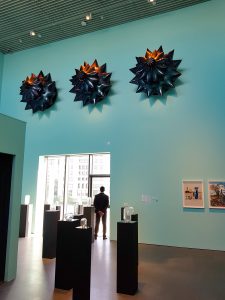
Fig. 4: Installation view of Crude exhibition. Monira Al Qadiri, Flower Drill (2016) is on the wall. Photo by Sabrina DeTurk.
Sculptural installations featured prominently in the exhibition. For example, Monira Al Qadiri’s Flower Drill (2016, Fig. 4), displayed high on the wall in one of the galleries, features fiberglass forms based on the design of drill heads and coated in two-toned automotive paint, connecting the work to both the initial and final stages of oil production and consumption. Alessandro Balteo-Yazbek’s Last Oil Barrel is a tiny wooden sculpture of a barrel, whose price is linked to oil futures and whose value will be determined only at some unspecified date in the future when a sale is fixed, reflecting the connections between the commodity value of both art and oil. The artist identifies the date of the work as “postponed,” indicating that it remains in some way incomplete until that time.
Although Crude was an intellectually rigorous and aesthetically compelling first exhibition from the Jameel Arts Centre, it remains to be seen whether there will be a sufficient audience for this type of show in Dubai over the long term. While the center’s opening weekend saw packed galleries, a weekday in January found the author almost alone in the spaces. The question of representation and inclusion of Emirati artists will undoubtedly also be raised at some point in the center’s development.
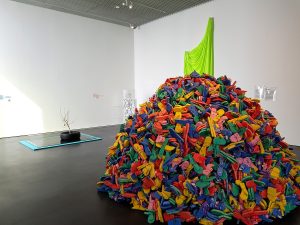
Fig. 5: Installation view of Crude exhibition. Hassan Sharif, Slippers and Wire (2009) is in the foreground. Photo by Sabrina DeTurk
A sculpture by the pioneering Emirati conceptualist artist Hassan Sharif (Fig. 5) was included in Crude and works by Emirati sculptors Shaikha Al-Mazrou and Mohammed Ahmed Ibrahim were shown in the lobby and outside garden respectively. However, this is but a small sample of the variety of contemporary art being produced in the United Arab Emirates and local artists may, understandably, begin to call for greater visibility in this high-profile contemporary arts space. The Jaddaf Waterfront remains under construction and as yet there is not a sustained community to support the idea of the Jameel Arts Centre thriving as a local creative hub. That said, the potential for growth and development is there and the openness with which the center is positioning itself is welcome in a city where the arts scene can often feel closed and difficult to penetrate. Jameel Arts Centre is a welcome addition to the creative landscape of Dubai and will hopefully continue to develop as a space for contemporary expression.
News from the Art and Academic Worlds
posted by CAA — March 20, 2019
Want articles like these in your inbox? Sign up: collegeart.org/newsletter
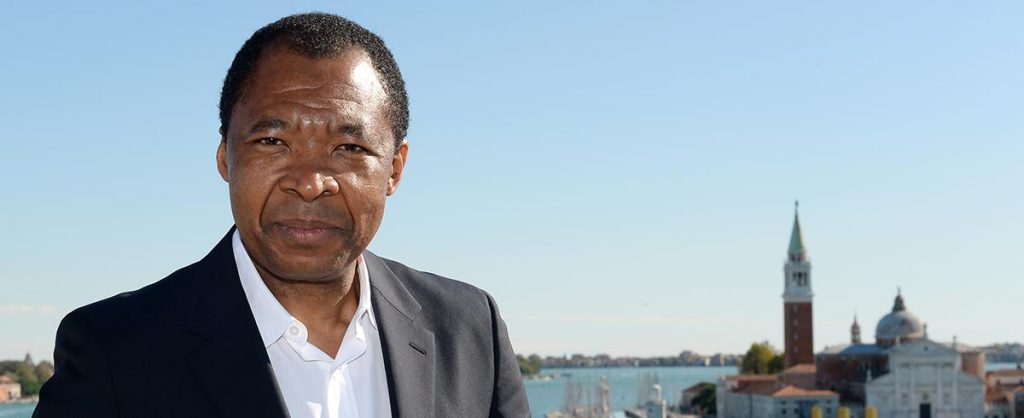
Okwui Enwezor at the Venice Biennale, 2015. Courtesy: La Biennale di Venezia, photo: Giorgio Zuchhiatti via Frieze
Culture Ministers from 16 German States Agree to Repatriate Artifacts Looted in Colonial Era
The ministers agreed to work with museums and institutions to develop repatriation procedures with “the necessary urgency and sensitivity.” (The Art Newspaper)
How Curator Okwui Enwezor (1963-2019) Changed the Course of Art
A tribute to the Nigeria-born poet, critic and curator, who passed away last week at the age of 55. (Frieze)
‘What Does It Take?’: Admissions Scandal Is a Harsh Lesson in Racial Disparities
“This scandal exposed the fact that there is a misplaced emphasis on so-called affirmative action inequities, rather than privilege.” (New York Times)
The Rapid Closure of Art Institutes Across America
Dream Center, a Christian nonprofit with no experience in higher education, has imploded, taking thousands of students—and millions in student loans—down with them. (Hyperallergic)
The Undiscussed Sexual Exploitation Buried in Matisse’s Odalisque Paintings
“So ingrained is exploitation in our understanding of female sexuality within (and outside of) art history that these incredibly basic readings recede into the background and are deemed somehow radical.” (Hyperallergic)
Curator Cuts at Leicester Museums Criticized as Disastrous
Museum leaders in the UK have condemned a cost-cutting proposal to replace curators with an “engagement team.” (The Guardian)
Serve on a CAA Editorial Board, Committee, or Jury
posted by CAA — March 20, 2019
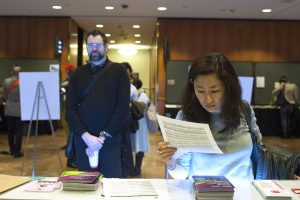
Attendees at the 2019 Annual Conference in New York. Photo: Ben Fractenberg
Each spring, members have the opportunity to provide critical service to the field and gain an inside view by volunteering to work on a CAA editorial board, committee, or jury.
Any member may self-nominate for the following positions or (after ascertaining interest) nominate another member. For more information, please click on the links below.
CURRENT OPPORTUNITIES
All deadlines for 2019 have passed.
CLOSED OPPORTUNITIES
Art Journal Open—Editor-in-Chief
Deadline: April 1
caa.reviews—Editor-in-Chief
Deadline: April 1
caa.reviews—Four Field Editors
Design History, Eighteenth-Century Art, Architecture and Urbanism, Theory and Historiography
Deadline: April 15
The Art Bulletin—Editorial Board Members
Deadline: April 15
Annual Conference—CAA Council of Readers
New this year, we’re asking members to serve a crucial role in shaping conference content.
Deadline: April 18
Annual Conference—Annual Conference Chair
Deadline: April 29
Annual Conference—Awards for Distinction Juries
Deadline: May 13
Millard Meiss Publication Fund—Jury Members
Deadline: May 13
Professional Development Fellowships in Art History and Visual Art—Jury Members
Deadline: May 13
Professional Committees—Seeking New Members
Committees: Design, Diversity Practices, Intellectual Property, Women in the Arts, Education, International, Museum, Professional Practices, Services to Artists, Student and Emerging Professionals
Deadline: September 18
CAA Announces Departure of Executive Director Hunter O’Hanian at End of Contract
posted by CAA — March 19, 2019
College Art Association Board President Jim Hopfensperger and Executive Director/CEO Hunter O’Hanian announced last Friday to staff and internal constituents that O’Hanian will be leaving CAA upon conclusion of his current three-year contract in June.
During his time as executive director, O’Hanian oversaw numerous organizational changes including a successful rebranding, a streamlining of membership structures, and improvements to staffing and financial reporting. In addition, he supervised significant changes to programs including increases to the number of CAA Annual Conference sessions and awards, renewed engagement with CAA Affiliated Societies, a new contract with CAA’s co-publisher (Routledge, Taylor & Francis), and plans for launching year-round programs.
“Hunter has led CAA with great intelligence, empathy, energy, and passion, and the association has enjoyed many successes these past three years,” said Hopfensperger. “In particular, the board of directors is grateful for his commitment to diversity and inclusion, and his efforts to better position CAA for success as both a learned society and a professional association.”
“For me, it’s been an exciting and fulfilling experience,” said O’Hanian. “I have enjoyed meeting and working with the members, staff and board, while strengthening our programs. Making change is never easy, especially for an association with an 107-year history. But I could not be prouder of the staff at CAA, the board of directors, the committees and editorial boards, and the members of this organization for their work ethic and feedback. I believe we have made a stronger association.”
As O’Hanian concludes his service, the board of directors will begin a search for its next executive director this spring with the hopes of bringing on a new leader by year’s end. In addition, an announcement concerning plans for interim leadership through the transition will be forthcoming.
For Third Year in a Row, Trump Administration Threatens to Cut NEA and NEH Funding
posted by CAA — March 19, 2019
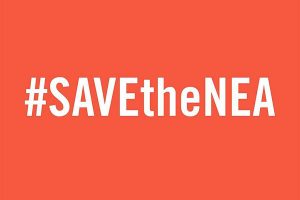
For the third consecutive year, the Trump administration is aiming to eliminate the National Endowment for the Arts and the National Endowment for the Humanities.
Trump unveiled a $4.75 trillion budget—the largest in federal history—on March 11, but details about his plans for the NEA and NEH were announced yesterday in the administration’s full proposal. According to the documents, the NEA’s budget is marked at $29 million and the NEH’s is at $38 million—which the proposal describes as “sufficient funding for orderly termination of all operations over two years.”
Since 2017, Trump has been vocal in his desire to eliminate the two agencies entirely. In 2019, each of the agencies was allocated a budget of $155 million, despite similar calls for elimination in 2018 and 2019. The US federal budget for 2020 will ultimately be decided by Congress.
We’ll be fighting back again this year and hope that you do, too. The most effective way to make your voice heard is through your local representatives. Call. Email. Write letters.
Urge your representatives to sign on to this NEA funding letter and this NEH funding letter, which ask for budgets of $167.5 million for each agency.
Signing deadline: March 27, 2019
Click here to access the CAA Arts and Humanities Advocacy Toolkit.



